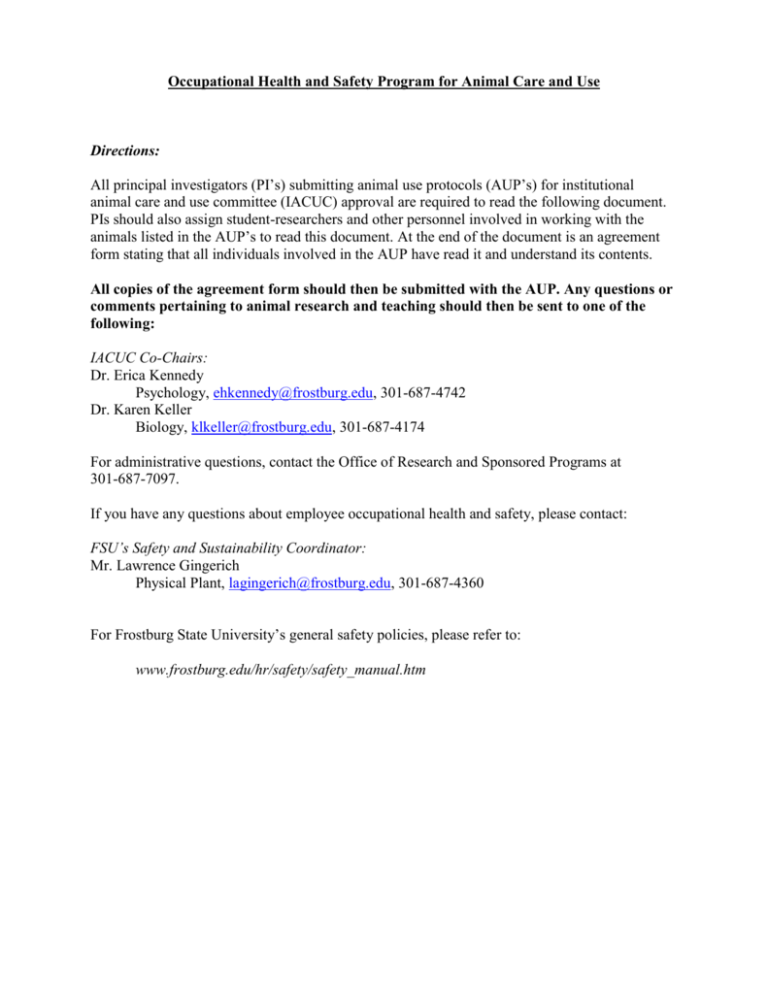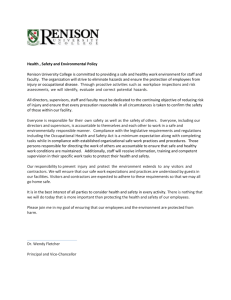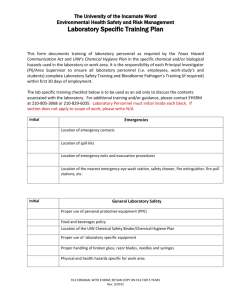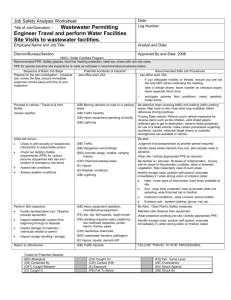
Occupational Health and Safety Program for Animal Care and Use
Directions:
All principal investigators (PI’s) submitting animal use protocols (AUP’s) for institutional
animal care and use committee (IACUC) approval are required to read the following document.
PIs should also assign student-researchers and other personnel involved in working with the
animals listed in the AUP’s to read this document. At the end of the document is an agreement
form stating that all individuals involved in the AUP have read it and understand its contents.
All copies of the agreement form should then be submitted with the AUP. Any questions or
comments pertaining to animal research and teaching should then be sent to one of the
following:
IACUC Co-Chairs:
Dr. Erica Kennedy
Psychology, ehkennedy@frostburg.edu, 301-687-4742
Dr. Karen Keller
Biology, klkeller@frostburg.edu, 301-687-4174
For administrative questions, contact the Office of Research and Sponsored Programs at
301-687-7097.
If you have any questions about employee occupational health and safety, please contact:
FSU’s Safety and Sustainability Coordinator:
Mr. Lawrence Gingerich
Physical Plant, lagingerich@frostburg.edu, 301-687-4360
For Frostburg State University’s general safety policies, please refer to:
www.frostburg.edu/hr/safety/safety_manual.htm
Occupational Health and Safety Program – Rationale and Background
Rationale:
Public Health Service (PHS) states in its Guide for the Care and Use of Laboratory Animals:
[Copyright © National Academy of Sciences. All rights reserved.]
“An occupational health and safety program must be part of the overall animal care and use
program (CDC and NIH 1993; CRF 1984a,b,c; PHS Policy). The program must be consistent
with federal, state, and local regulations and should focus on maintaining a safe and healthy
workplace. The program will depend on the facility, research activities, hazards, and animal
species involved.” and; “ Zoonoses and occupational health and safety issues should be
reviewed by the IACUC to ensure that field studies do not compromise the health and safety of
other animals or persons working in the field.”
Background:
In order to use vertebrate animals in teaching and research Frostburg State University
complies with a number of regulations, guidelines and policies. Many of those regulations and
guidelines require the establishment of an occupational health and safety program for individuals
who work with animals or their non-preserved tissues. The goal of the Occupational Health and
Safety program (OHS) at Frostburg State University is to ensure that all persons who have
contact with animals are made aware of the potential hazards of working with animals,
procedures and equipment that should be used to reduce the risk of exposure to specific hazards.
Individuals working with animals in research or educational settings are potentially at
risk of illness or injury. These risks include, but are not limited to: zoonotic diseases (diseases
that are transmissible from animals to humans); animal allergen exposure resulting in mild to
severe allergic reactions in humans; bites, kicks, and scratches; and injury from caging
equipment and/or cleaning and maintenance materials.
Purpose:
The purpose of this document is to make faculty, staff and students aware of the risks that
may be present in the animal facility, laboratories or in the field. The document is also intended
to establish what precautions, procedures, and equipment may be used to minimize the risks to
health and well-being.
Introduction:
It is the responsibility of the PI of each IACUC-approved protocol to ensure that all
workers under PI’s supervision (co-investigators, staff, students, and volunteers) or who are
otherwise working on the PI’s protocol(s) and who have contact with animals or their tissues are
informed of the potential hazards or risks involved. They must also be made aware of the
procedures and personal protective equipment (PPE) available to prevent and reduce hazards or
risks of injury or exposure to infectious disease. Employees (hereafter “employees” will refer to
student volunteers, student researchers, staff and faculty, including principal investigators) are
expected to follow established safe work practices, to practice appropriate personal hygiene, and
to properly use and care for required PPE. Employees having health and safety questions about
their work tasks and work environment should ask their supervisor or the PI for answers to those
questions. Employees must inform their supervisors of any accident or injury that occurs to them
and should advise their supervisors of symptoms they have that may be associated with a
zoonotic disease. Employees who are pregnant, planning conception, or who are immunecompromised or immune-suppressed should consult with the FSU Safety Officer, prior to
handling animals or chemicals, to determine if any additional training, provisions, or
consultation with a licensed physician is necessary for participation in the program.
Importance of Prevention
Accidents, injuries, and exposures can be prevented through use of appropriate practices,
procedures, and PPE. Supervisors must ensure that the duties of their employees have been
properly assessed to reduce employee risk. The supervisor or PI shall implement appropriate
measures to ensure employee protection and workplace safety. The supervisor or PI shall ensure
that the potentially exposed employee understands the use and care of PPE, personal hygiene,
and proper safety practices essential to preventing animal\workplace injury or illness.
Personal Hygiene Practices
PIs and lab supervisors must establish hygiene standard practices for their respective
areas and identify the hazard risks associated with those areas. Basic hygiene policies in animal
housing or procedure areas include: no eating, drinking, smoking, applying of cosmetics,
chewing of gum or tobacco use. Gloves, gowns, lab coats, bonnets, booties and other items of
protective clothing must be worn where indicated by the PI and lab supervisor. Frequent handwashing, both in and out of animal areas, must also be performed. Any protective clothing worn
in an animal facility or procedure area must be removed before leaving the laboratory. These
procedures prevent airborne animal dander and other contaminants from adhering to the
employee’s clothing, hair, and skin.
Similar practices should be observed in field studies whenever possible and employees
should refrain from eating or drinking until hands are completely disinfected after handling any
animals or animal equipment.
Availability and Use of PPEs
PPE includes but is not limited to: lab coats, gowns, scrub suits, latex gloves, safety
gloves for handling hot items, goggles, safety glasses, face shields, head covers, hearing
protection, shoe covers, safety shoes, “Tyvek” full-body suits, face masks, half-face or full-face
respirators, and PAPR (Powered Air Purifying Respirator) devices. PPE protects animal handlers
and research staff from a wide range of workplace risks, including animal allergens, disease
exposure, and mechanical injury. The selection of appropriate PPE is based upon specific
workplace risks as identified by the PI or lab supervisor, and will also be reviewed by the
Environmental Health and Safety Office to confirm the assessment and assignment of
appropriate PPE. It is important that employees work with their supervisor(s) and the EHS Office
to ensure that the tasks the employee is to perform have been assessed and that the proper PPE
has been identified and provided for the employee's use.
Laboratory or Field Hazards
Equipment Hazards
Mechanical equipment may pose a risk of injury to employees. Supervisors must train all
personnel in the proper operation, use, and maintenance of equipment. Employees are expected
to follow established Standard Operating Procedures (SOPs) that include information concerning
safe use of equipment, recommended PPE and accident prevention.
Electrical Hazards
Wet conditions may be present during room and hallway cleaning and in cage-wash
areas. The presence of electrical devices in those areas could pose a risk of electric shock. Areas
where fish tanks or aquaria are maintained pose similar hazards. Ensure that electrical outlets in
those areas are waterproof and are ground fault interrupt (GFI) circuits. Extension cords must not
be used as a long-term solution in place of permanent wiring. Locations where a permanently
wired in socket is necessary must be installed by a qualified electrician. Extension cords also
create tripping hazards. A qualified electrician must make all electrical installations and repairs.
Chemical Hazards
A variety of chemicals are required in animal facilities for cleaning, disinfection, and
sterilization. Those chemicals may cause irritation or burns to skin, eyes, and respiratory
passages. Safety Data Sheets (SDSs) or Material Safety Data Sheets (MSDS) must be maintained
for each chemical to provide both workers and emergency personnel with the proper procedures
for handling or working with a particular chemical. SDSs include information such as physical
data, toxicity, health effects, first aid, reactivity, storage, disposal, protective equipment, and spill
or leak procedures.
Physical Hazards
High noise from animal handling or noisy equipment use may also cause injury to
employees. Proper hearing protection shall be selected to reduce the risk of hearing loss. Use of
infrared or ultraviolet light (nonionizing) or ionizing radiation shall be discussed with
Environmental Safety and Health prior to use.
Animal-Related Hazards
Physical Injuries
Workers risk potential injury from animal bites, kicks, scratches, and similar animalinflicted wounds. Supervisors, PI’s and instructors must train new personnel in proper animal
handling and restraint procedures for each species the employee is required to work with before
that employee begins work with animals.
Infectious Hazards
Most commercially-produced and supplied laboratory rodents are free of pathogens.
However, rodents purchased from pet stores and other vertebrates, particularly animals captured
during field studies may carry diseases that could be transmissible to humans (zoonotic, zoonoses).
Allergic Reactions
Allergens may be carried by air currents in the animal room and can come into contact
with a person’s skin, eyes, nasal passages, and lungs where allergic reactions may occur. For
Example: People with allergies to rodents may have sneezing, congestion, itchy and watery eyes,
and skin rash or itching when they are exposed to rodents or to rooms and equipment used to
house rodents. In this example a surgical mask is not adequate to control allergen exposure
while working with rodents.
Non-hazardous Carcasses
Animal carcasses may be disposed of in a landfill provided the animal does not contain
infectious agents or hazardous materials creating a hazardous waste. Carcasses may contain
small amounts of chemicals as long as the chemical does not meet the definition of a hazardous
waste. Investigators should call the Safety Office if they are unsure about whether a chemical is
categorized as “hazardous waste.”
Chemically Contaminated Waste and Carcasses
IACUC-approved protocols involving hazardous chemicals specify handling requirements for
contaminated wastes and animal carcasses. In some instances, wastes and carcasses must be
bagged and stored in designated barrels. If you have hazardous waste, call the Safety Office for a
pick up. Ensure that materials are stored properly. Do NOT pour hazardous waste down the drain
or throw into trash cans.
Response to Injuries
Seek Medical Attention Promptly
If you are injured on the job, promptly report the incident to your supervisor even if it seems
relatively minor. Your supervisor should fill out an Incident Report following the guidelines in
the Accident Reports and Record Keeping section of the Risk Management Policy (available on
the FSU Human Resources) within 24 hours. Clean all minor cuts and abrasions immediately
with antibacterial soap, and then protect them from dirt or animal secretions until they have
healed. If the injured person is an employee (faculty/staff/student worker), he or she shall go to
the Brady Health Center (or if after hours, the Emergency Room at the Western Maryland Health
System), and then the employee should contact the University Safety Officer. Tell the physician
that the injury was the result of working with an animal and specify the species and other related
information concerning zoonoses, chemicals, etc. if known.
Additional Reporting and Steps for Bites or Several Scratches
1. Where possible to do so safely, identify the biting animal and all associated animals. If
captured in a live trap (particularly including potentially feral cats and all wild animals), DO
NOT release the animal. Great care should be exercised when moving the live trap to avoid
further bites from the animal inside it. The live trap should only be handled by persons
with adequate titer protection provided by a rabies prophylaxis vaccination. If possible,
preserve the life of the biting animal for diagnostic purposes. Any animal that bites and
escapes shall be observed by the Principal Investigator, if it is safe and if it is possible to do
so, for reporting purposes where appropriate.
2. For laboratory animals, observe 10 days for signs of abnormal behavior. Notify the
Veterinarian if there is any sign of sickness or altered behavior in the biting animal during the
quarantine/observation period.
a. During the period of quarantine, the quarantine card, signed by the examining veterinarian,
shall remain on the cage. The animal shall not be removed from the cage or room and shall
not be used for experimental purposes.
b. If the biting animal dies before or during the quarantine period, the Veterinarian must be
notified, and the whole carcass shall be refrigerated. Do not freeze the carcass, as this
interferes with diagnostic procedures.
c. Animals surviving the quarantine period will be released to the investigator for further use.
3. For wild animals, maintain custody where possible and safe to do so, and contact the
Maryland Department of Health (MDH), per the Maryland Rabies Policy.
a. Instruction provided by MDH for wound care and other post-bite treatment, as well as for
the disposition of the animal, must be followed.
b. A veterinarian may examine the animal and institute the proper quarantine measures (not
required for laboratory rats and mice).
c. However, the animal is most likely to be required to be taken promptly to the nearest state
laboratory for examination.
Frostburg State University’s Occupational Health and Safety Agreement
I have read AND UNDERSTAND the Frostburg State University Occupational Health and
Safety Education document.
I agree to follow the recommendations and the warnings contained in the document.
I agree to revisit the document whenever I begin to work with new animal species and/or
zoonotic agents.
Further, I agree to inform my primary physician, as well as any other appropriate medical
professionals, that I work with research or wild animals when I visit said primary care
provider(s).
Date: ____________
Print/Type Name: _________________________________________
Signature: _________________________________________
Name of Faculty/Supervisor (if you’re a student researcher): __________________________
Please print this page and send the signed Agreement form to the IACUC Administrator







